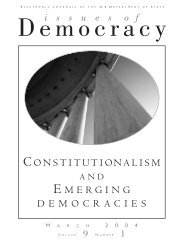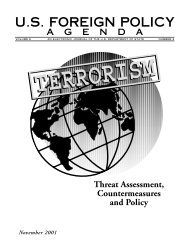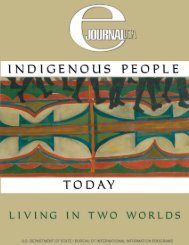Working for Women Worldwide - Embassy of the United States
Working for Women Worldwide - Embassy of the United States
Working for Women Worldwide - Embassy of the United States
You also want an ePaper? Increase the reach of your titles
YUMPU automatically turns print PDFs into web optimized ePapers that Google loves.
Success Story<br />
Afghanistan<br />
Ordinary <strong>Women</strong> Doing Extraordinary Things<br />
One <strong>of</strong> <strong>the</strong> critical steps in helping<br />
societies rebuild after conflict is providing<br />
support to women and children. The<br />
<strong>United</strong> <strong>States</strong> takes a holistic approach<br />
to helping women in post-conflict societies,<br />
zfrom access to to education and training to improving<br />
health, safety, and political empowerment.<br />
Afghanistan is a case in point. In only three years<br />
since <strong>the</strong> fall <strong>of</strong> <strong>the</strong> Taliban, Afghanistan experienced<br />
<strong>the</strong> largest return <strong>of</strong> refugees in modern history. Many<br />
<strong>of</strong> <strong>the</strong> nearly four million Afghanis who had fled to<br />
Iran and Pakistan—nearly half <strong>of</strong> <strong>the</strong>m women and<br />
children—are now streaming back into <strong>the</strong>ir homeland.<br />
Three years ago, over eight million Afghans age<br />
six to 30 had little or no education. Today, approximately<br />
4.8 million children are in school, and <strong>of</strong> <strong>the</strong>se,<br />
nearly 40 percent are girls—<strong>the</strong> highest number ever<br />
in Afghan history.<br />
<strong>Women</strong> are active in shaping <strong>the</strong> country’s new<br />
government. <strong>Women</strong> held 102 <strong>of</strong> <strong>the</strong> 500 seats on <strong>the</strong><br />
Loya Jirga, or national assembly, which in January<br />
2004 adopted a new constitution guaranteeing women<br />
equal rights with men and a significant presence in<br />
both houses <strong>of</strong> <strong>the</strong> new parliament. Nearly every<br />
woman involved in <strong>the</strong> Loya Jirga had received some<br />
political training through U.S.-funded projects. The<br />
newly elected president, Hamid Karzai, already has<br />
appointed women leaders to his cabinet.<br />
<strong>Women</strong>’s political participation in Afghanistan<br />
was especially significant and visible in <strong>the</strong> October<br />
2004 presidential election: They accounted <strong>for</strong> nearly<br />
41 percent <strong>of</strong> registered voters. “In snowstorms, in<br />
sandstorms, in heavy rains, women came out to vote,<br />
and in some cases <strong>the</strong> number <strong>of</strong> women voting outnumbered<br />
<strong>the</strong> men,” says Charlotte Ponticelli, senior<br />
coordinator <strong>for</strong> international women’s issues at <strong>the</strong><br />
U.S. Department <strong>of</strong> State. “This is a country where<br />
three years ago <strong>the</strong> women had no voice at all, were<br />
subjected to horrible torture when <strong>the</strong>y went out <strong>of</strong><br />
<strong>the</strong>ir houses, had no education, no chance <strong>for</strong> jobs, certainly<br />
no political involvement. Now <strong>the</strong>y are not only<br />
voting by <strong>the</strong> millions, but <strong>the</strong>y are also running <strong>for</strong><br />
<strong>of</strong>fice.”<br />
Of course, in a land long-ravaged by war and<br />
tyranny, significant challenges remain. Life expectancy<br />
is only 46 years, even less <strong>for</strong> many women.<br />
Afghanistan’s maternal mortality rate is among <strong>the</strong><br />
highest in <strong>the</strong> world. One reason is that many Afghan<br />
women give birth without trained medical assistance.<br />
Nationwide, 86 percent <strong>of</strong> Afghan women are illiterate.<br />
In rural areas, <strong>the</strong> figure reaches 92 percent.<br />
The good news is that <strong>the</strong> country is making<br />
tremendous strides on <strong>the</strong>se fronts. The <strong>United</strong> <strong>States</strong><br />
has funded more than 200 programs that benefit<br />
women and girls. Basic health care is now available to<br />
nearly five million citizens in 13 provinces, and services<br />
<strong>for</strong> women and children are more accessible with <strong>the</strong><br />
construction <strong>of</strong> women’s health wings and <strong>the</strong> training<br />
<strong>of</strong> about 5,000 midwives and health workers. U.S. aid<br />
has helped to build or rebuild more than 200 schools,<br />
provide 25 million textbooks, and train 7,000 teachers.<br />
A teacher-training institute opened in September<br />
2004. Seventeen <strong>Women</strong>’s Centers, each providing<br />
day care services and outfitted with computers, audiovisual<br />
equipment, and a library, will <strong>of</strong>fer safe havens<br />
where women can acquire <strong>the</strong> basic education, health<br />
services, job skills, and political know-how denied<br />
<strong>the</strong>m under <strong>the</strong> Taliban.<br />
To tackle <strong>the</strong> crisis <strong>of</strong> maternal mortality, <strong>the</strong> U.S.<br />
government has funded training programs <strong>for</strong> medical<br />
personnel. With backing by <strong>the</strong> U.S. Agency <strong>for</strong><br />
48












